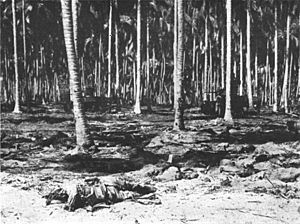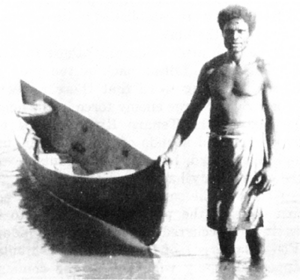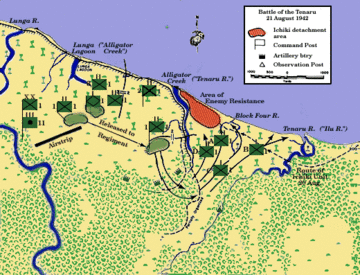Battle of the Tenaru facts for kids
Quick facts for kids Battle of the Tenaru |
|||||||
|---|---|---|---|---|---|---|---|
| Part of the Pacific Theater of World War II | |||||||
|
|||||||
| Belligerents | |||||||
| Commanders and leaders | |||||||
|
|||||||
| Units involved | |||||||
|
|
|||||||
| Strength | |||||||
| 3,000 | 917 | ||||||
| Casualties and losses | |||||||
| 41–44 killed |
|
||||||
The Battle of the Tenaru was a major land battle during World War II. It happened on August 21, 1942, on the island of Guadalcanal. This battle was the first big attack by the Imperial Japanese Army against Allied forces on the island.
In this battle, U.S. Marines fought off an attack by Japanese soldiers. The Marines were led by U.S. Major General Alexander Vandegrift. The Japanese force was commanded by Colonel Kiyonao Ichiki.
The Marines were protecting an important airfield called Henderson Field. The Allies had captured this airfield on August 7. Colonel Ichiki's unit was sent to Guadalcanal to take back the airfield and push the Allied forces off the island.
The Japanese leaders did not know how many Allied soldiers were on Guadalcanal. They thought there were only a few. So, Ichiki's unit launched a surprise attack at night. They charged straight at the Marine positions at Alligator Creek. A local scout named Jacob C. Vouza warned the Americans just before the attack.
The Japanese suffered huge losses. The Marines then counterattacked the remaining Japanese soldiers. About 800 of Ichiki's 917 soldiers were killed. This battle showed the Japanese that the Allied forces on Guadalcanal were much stronger than they had thought.
Contents
Battle of the Tenaru
Setting the Stage
During World War II, the United States and its allies landed on Guadalcanal and nearby islands in August 1942. Their goal was to stop Japan from using these islands as bases. They also wanted to protect the supply routes between the U.S. and Australia. This marked the start of the six-month-long Guadalcanal campaign.
The Allied forces surprised the Japanese. They quickly took control of the islands and an airfield being built on Guadalcanal. This airfield was later named Henderson Field. However, Japanese warships attacked the Allied ships on August 8. This battle, called the Battle of Savo Island, caused the Allies to lose several ships. Because of this, the Allied ships left before unloading all their heavy equipment and food.
The Marines on Guadalcanal focused on building defenses around the airfield. They moved supplies and worked to finish the airfield. Major General Alexander Vandegrift had about 11,000 troops. They set up a defense line around the Lunga Point area. Food was scarce, so soldiers ate only two meals a day.
Japan's military leaders decided to send troops to retake Guadalcanal. Lieutenant-General Harukichi Hyakutake was in charge of this mission. Colonel Kiyonao Ichiki's regiment was the closest Japanese unit. So, they were sent first.
Japanese planes flew over Guadalcanal on August 12. They saw few U.S. troops and no large ships. This made Japanese leaders believe most Allied troops had left. But this was wrong; no Allied troops had left. Hyakutake ordered 900 of Ichiki's troops to land quickly and attack the airfield.
Colonel Ichiki and 916 of his soldiers landed at Taivu Point on August 19. This was about 35 kilometers (22 miles) east of the main Allied defenses. Ichiki was told to scout the American positions and wait for more of his troops. But Ichiki was very confident. He decided to attack right away, believing his men were unbeatable. He even wrote in his journal that he would enjoy victory on August 21.
Ichiki left about 100 men behind. He marched west with 800 soldiers. They camped a few miles from the U.S. Marine defenses. The U.S. Marines had received reports that Japanese troops had landed. They sent out patrols to find out more.
Getting Ready for Battle

Local scouts, including retired Sergeant Major Jacob C. Vouza, helped the Marines. They reported that Japanese troops were east of Lunga Point. On August 19, a Marine patrol of 60 men went to investigate.
At the same time, Ichiki sent his own patrol of 38 men forward. Around noon, the Marine patrol ambushed the Japanese patrol. They killed most of them. The Marines found papers on the dead Japanese officers. These papers showed that a much larger Japanese force was nearby.
Knowing an attack was coming from the east, the U.S. Marines prepared their defenses. They set up their lines along the Ilu River, which the Marines called Alligator Creek. This "creek" was actually a tidal lagoon. It was separated from the ocean by a sandbar.
Colonel Clifton B. Cates commanded the 1st Marine Regiment. He placed his troops along the west side of Alligator Creek. To defend the sandbar, he added 100 men with two 37mm anti-tank guns. These guns could fire special "canister shot" that acted like giant shotguns. Marine artillery also targeted areas on the east side of the creek. The Marines worked all day on August 20 to get ready.
Ichiki learned his patrol had been wiped out. He quickly moved his main force forward. They marched through the night of August 19. By early morning on August 20, they were just a few miles from the Marine lines. Ichiki prepared his troops to attack that night.
The Attack Begins
Just after midnight on August 21, Ichiki's main force reached the east bank of Alligator Creek. They were surprised to find Marine positions there. The Marines had not expected the Japanese to be so close to the airfield. Marine listening posts heard noises from the Japanese. They then pulled back to the west bank of the creek.
At 1:30 AM, Ichiki's troops opened fire with machine guns and mortars. A first wave of about 100 Japanese soldiers charged across the sandbar. Marine machine guns and the 37mm cannons fired. Most of the Japanese soldiers were killed as they crossed. A few reached the Marine lines. They fought hand-to-hand and captured some front-line spots. But Marine reserves quickly counterattacked. They killed most of the Japanese who had broken through. This first attack ended about an hour after it began.
At 2:30 AM, a second wave of about 150 to 200 Japanese troops attacked. They charged across the sandbar again. Almost all of them were wiped out. Some surviving Japanese officers told Ichiki to pull back. But Ichiki refused.
As the Japanese regrouped, their mortars shelled the Marine lines. The Marines fired back with their own artillery and mortars. Around 5:00 AM, another wave of Japanese attacked. This time, they tried to go around the Marine positions. They waded through the ocean surf to attack up the beach. The Marines met them with heavy machine gun and artillery fire. This caused many more Japanese casualties. The Japanese had to retreat back to the east bank. For the next two hours, both sides exchanged fire across the sandbar and creek.
Marine Counterattack
Despite their heavy losses, Ichiki's troops stayed on the east bank. They seemed unable or unwilling to retreat. At daybreak on August 21, the Marine commanders decided to counterattack. The 1st Battalion, 1st Marine Regiment, crossed Alligator Creek further upstream. They moved around Ichiki's troops from the south and east. This cut off any way for the Japanese to escape. The Marines then pushed Ichiki's soldiers into a small area. This area was a coconut grove on the east bank of the creek.
Planes from Henderson Field attacked Japanese soldiers trying to escape down the beach. Later that afternoon, four or five Marine M3 Stuart tanks attacked. They crossed the sandbar into the coconut grove. The tanks fired their machine guns and cannons. They also rolled over any Japanese soldiers who could not or would not get out of the way. After the tank attack, the area was devastated.

By 5:00 PM on August 21, the Japanese resistance ended. As Marines walked around the battlefield, some wounded Japanese soldiers opened fire. They killed or wounded several Marines. After this, Marines shot any Japanese soldier on the ground who moved. About 15 injured Japanese soldiers were captured. Around 30 Japanese troops managed to escape. They rejoined their unit's rear group at Taivu Point. In total, about 800 Japanese soldiers were killed in the fighting.
What Happened Next
For the U.S. and its allies, winning the Battle of the Tenaru was very important. Allied soldiers had faced many defeats by the Japanese Army. Now, they knew they could win a land battle. This battle also set a pattern for the rest of the war in the Pacific. Japanese soldiers often refused to surrender. They would try to keep fighting, even when badly wounded.
The battle also affected the Japanese. Their soldiers believed they were unbeatable. By August 25, most of Ichiki's survivors reached Taivu Point. They radioed their headquarters. They reported that Ichiki's unit was "almost wiped out." Japanese Army leaders were shocked. They then planned to send many more troops to Guadalcanal. They still wanted to capture Henderson Field. The next big Japanese attack on the Marine defenses happened about three weeks later. It was called the Battle of Edson's Ridge. That attack used a much larger force and came very close to winning.
In Movies and TV
The Battle of the Tenaru is shown in the 1945 movie Pride of the Marines. This film is about Al Schmid, a Marine who fought in the battle. Marines Corporal Lee Diamond, Private First Class John Rivers, and Private Schmid fought bravely. They were credited with killing 200 Japanese soldiers. They received the Navy Cross, a high award for their actions. Rivers died, and Schmid and Diamond were badly wounded.
In 2010, the battle was the main event in the first episode of the miniseries The Pacific. This show was produced by Steven Spielberg and Tom Hanks.
Images for kids




